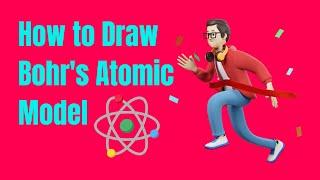
How to Draw Bohr Atomic Model. Watch this video to find out!
📌 Receive Comprehensive Mathematics Practice Papers Weekly for FREE
Click this link to get: ▶️▶️▶️ https://iitutor.com/email-list/ ◀️◀️◀️
In 1912-13 Niels Bohr created a new atomic model of the atom, which combined Planck’s concept of quantised emission and absorption of light with Rutherford’s nuclear model. Unlike Rutherford’s atomic model, the model proposed by Bohr was stable and could be used to explain the atomic line spectra produced by hydrogen.
Bohr’s model was based on the following assumptions (postulates):
1 Electrons orbit a dense positively charged nucleus, just as Rutherford proposed, but instead of an electron being free to orbit in any orbital, electrons could only orbit in specific stationary energy states. When an electron orbits the nucleus in one of these stationary states (orbitals) it will not radiate electromagnetic radiation.
2 Stable electron orbitals are specified by the following quantum rule: Where h is Planck’s constant and n is an integer called principal quantum number.
3 Emission and absorption of a photon of electromagnetic radiation correspond to a change from
pne stationary state of the atom to another. The difference in energy between the initial and final states is equal to the energy of the photon.‘bright-line’ spectrum. If the slit has a different shape, so would the bright lines on the screen.
In his first postulate, Bohr put forward one of the most audacious hypotheses ever proposed in physics by predicting that electrons exist in states in which they do not radiate energy. The third postulate involves the quantum of energy being emitted or absorbed when an electron jumps from one stationary state to another and hence explains the origin of spectral lines. The quantisation condition (the second postulate) is really an intuitive guess.
The diagram shows that if a photon of light has just the right amount of energy to excite an electron from one stable orbital to another, it will be absorbed by the atom. For a photon to have a specific energy, the light must have a specific frequency (wavelength).
This is why only specific wavelengths of light will be absorbed by the atom. The energy of the absorbed photon must be equal to the energy difference between stationary states in the atom.
The excited atom may then lose energy by the electron returning to its original orbital, releasing a photon of light, again with a frequency related to the energy difference between the levels. By calculating the energy difference between stationary orbitals and setting this equal to the energy of a photon, Bohr was able to derive Balmer’s equation from the first principles. He showed the integers in Balmer’s equation were equivalent to the principal quantum number of the initial and the final stationary states when a photon is absorbed or radiated.
The energy difference between the orbitals was equal to the energy of the emitted or absorbed photon.
Drawbacks of the Model
The Bohr model takes the first step to introduce quantum theory to the hydrogen atom but it is only a first step. The model has the following limitations:
• it is impossible to calculate the wavelengths of the spectral lines of all other atoms.
• the Bohr model works reasonably well for atoms with one electron in their outer shell but does not work for any of the others.
• examination of spectra shows that the spectral lines are not of equal intensity but the Bohr model does not explain why some electron transitions would be favoured over others.
• careful observations with better instruments showed that there were other lines known as the hyperfine lines. There must be some splitting of the energy levels of the Bohr atom but the Bohr model cannot account for this.
• when a gas is excited while in a magnetic field, the emission spectrum produced shows a splitting of the spectral lines (called the Zeeman effect). Again, the Bohr model cannot account for this.
• finally, the Bohr model is a mixture of classical physics and quantum physics and this, in itself, is a problem.
Sample question
Outline the main limitations of the Rutherford model of the atom. How did the Bohr model overcome these limitations?
Solution
Rutherford's model was not stable because the orbiting electrons would emit electromagnetic radiation, lose energy and spiral into the nucleus. Rutherford's model also could not explain the emission spectra emitted by excited atoms.
Bohr's model overcame the first problem by assuming that in certain orbitals (stationary states) electrons would not emit radiation. Bohr's model explained emission and absorption spectra by assuming photons of light were emitted and absorbed when an electron moved between stationary states in an atom.
Click this link to get: ▶️▶️▶️ https://iitutor.com/email-list/ ◀️◀️◀️
In 1912-13 Niels Bohr created a new atomic model of the atom, which combined Planck’s concept of quantised emission and absorption of light with Rutherford’s nuclear model. Unlike Rutherford’s atomic model, the model proposed by Bohr was stable and could be used to explain the atomic line spectra produced by hydrogen.
Bohr’s model was based on the following assumptions (postulates):
1 Electrons orbit a dense positively charged nucleus, just as Rutherford proposed, but instead of an electron being free to orbit in any orbital, electrons could only orbit in specific stationary energy states. When an electron orbits the nucleus in one of these stationary states (orbitals) it will not radiate electromagnetic radiation.
2 Stable electron orbitals are specified by the following quantum rule: Where h is Planck’s constant and n is an integer called principal quantum number.
3 Emission and absorption of a photon of electromagnetic radiation correspond to a change from
pne stationary state of the atom to another. The difference in energy between the initial and final states is equal to the energy of the photon.‘bright-line’ spectrum. If the slit has a different shape, so would the bright lines on the screen.
In his first postulate, Bohr put forward one of the most audacious hypotheses ever proposed in physics by predicting that electrons exist in states in which they do not radiate energy. The third postulate involves the quantum of energy being emitted or absorbed when an electron jumps from one stationary state to another and hence explains the origin of spectral lines. The quantisation condition (the second postulate) is really an intuitive guess.
The diagram shows that if a photon of light has just the right amount of energy to excite an electron from one stable orbital to another, it will be absorbed by the atom. For a photon to have a specific energy, the light must have a specific frequency (wavelength).
This is why only specific wavelengths of light will be absorbed by the atom. The energy of the absorbed photon must be equal to the energy difference between stationary states in the atom.
The excited atom may then lose energy by the electron returning to its original orbital, releasing a photon of light, again with a frequency related to the energy difference between the levels. By calculating the energy difference between stationary orbitals and setting this equal to the energy of a photon, Bohr was able to derive Balmer’s equation from the first principles. He showed the integers in Balmer’s equation were equivalent to the principal quantum number of the initial and the final stationary states when a photon is absorbed or radiated.
The energy difference between the orbitals was equal to the energy of the emitted or absorbed photon.
Drawbacks of the Model
The Bohr model takes the first step to introduce quantum theory to the hydrogen atom but it is only a first step. The model has the following limitations:
• it is impossible to calculate the wavelengths of the spectral lines of all other atoms.
• the Bohr model works reasonably well for atoms with one electron in their outer shell but does not work for any of the others.
• examination of spectra shows that the spectral lines are not of equal intensity but the Bohr model does not explain why some electron transitions would be favoured over others.
• careful observations with better instruments showed that there were other lines known as the hyperfine lines. There must be some splitting of the energy levels of the Bohr atom but the Bohr model cannot account for this.
• when a gas is excited while in a magnetic field, the emission spectrum produced shows a splitting of the spectral lines (called the Zeeman effect). Again, the Bohr model cannot account for this.
• finally, the Bohr model is a mixture of classical physics and quantum physics and this, in itself, is a problem.
Sample question
Outline the main limitations of the Rutherford model of the atom. How did the Bohr model overcome these limitations?
Solution
Rutherford's model was not stable because the orbiting electrons would emit electromagnetic radiation, lose energy and spiral into the nucleus. Rutherford's model also could not explain the emission spectra emitted by excited atoms.
Bohr's model overcame the first problem by assuming that in certain orbitals (stationary states) electrons would not emit radiation. Bohr's model explained emission and absorption spectra by assuming photons of light were emitted and absorbed when an electron moved between stationary states in an atom.
Тэги:
#Niels_Bohr #atomic_model_of_the_atom #Rutherford’s_nuclear_model #Bohr’s_model #electromagnetic_radiation #Planck’s_constant #Emission_and_absorption #wavelength #Balmer’s_equation #Drawbacks_of_the_Model #Zeeman_effect #yt:cc=onКомментарии:
Deejay Tso - Umdali (Official Music Video) ft. M-Thulz, Randy P
Homebase Records
IMHO | (not) The Autocomplete Interview
IMHO: The Show
LALI JANJINE Karaoke keroncong | Nada wanita
Senox Keyboard
Обслуживание/Замена бензонасоса
ClubUazFan
La Segunda República Española. Su historia política | José Luis Climent
Ateneo Mercantil de Valencia


























